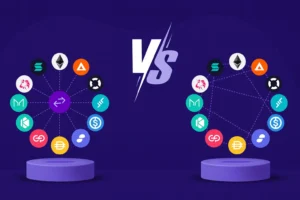
Security is a critical aspect of smart contracts. One of the biggest threats to these contracts is a type of attack known as a reentrancy attack. To protect against this, developers use a tool called a ” reentrancy guard.” This article will explain what a reentrancy guard is, how it works, and why it is essential for anyone involved in Smart Contract Development. We will also look at the role of Smart Contract Developers and Development Services in keeping contracts secure.
What is a Reentrancy Guard?
A Reentrancy Guard is a security mechanism designed to protect smart contracts from reentrancy attacks. A reentrancy attack occurs when a malicious contract repeatedly calls a function in the victim contract before the first call has been completed, potentially allowing the attacker to exploit the contract for illicit gains. This type of vulnerability is particularly dangerous in Ethereum and other Blockchain Environments where state changes can happen quickly. Reentrancy guards typically work by using a simple flagging mechanism. When a function is called, the guard checks if the contract is already executing that function. If it is, the guard will prevent further execution until the current call is completed. This helps to ensure that state changes in the contract are made securely and that no unexpected behavior can occur from repeated function calls.
Why Reentrancy Guard Matters for Smart Contracts?
Reentrancy Guards are important in Smart Contract Development because they add a layer of security that protects against reentrancy attacks. These attacks can lead to financial losses and damage the contract’s integrity. In the world of blockchain, where smart contracts often manage and transfer valuable assets, a reentrancy attack can take advantage of weaknesses in the code. This allows attackers to interfere with the contract before a transaction is finished.
By using reentrancy guards, developers can ensure that functions changing the contract’s state can only run one at a time. This prevents unauthorized access and helps keep users’ funds safe. Implementing these guards builds trust among users and investors and helps projects follow potential regulations, providing a stable and secure experience. As the importance of security in blockchain applications continues to grow, reentrancy guards are essential for protecting smart contracts, making them a key aspect of Smart Contract Development.
Reentrancy Guard Examples
Example 1: Basic Reentrancy Guard
In this example, we will create a simple bank contract that allows users to deposit and withdraw funds while preventing reentrancy attacks. The reentrancy guard will be implemented using a basic locking mechanism.
pragma solidity ^0.8.0;
contract SimpleBank {
mapping(address => uint) public balances; // Store user balances
bool private lock; // This variable will act as a lock
// Modifier to prevent reentrancy
modifier noReentrancy() {
require(!lock, "No reentrant calls allowed"); // Check if the lock is not active
lock = true; // Activate the lock
_; // Execute the function
lock = false; // Deactivate the lock
}
// Function to deposit money into the bank
function deposit() public payable {
balances[msg.sender] += msg.value; // Add the deposited amount to the user's balance
}
// Function to withdraw money from the bank
function withdraw(uint _amount) public noReentrancy {
require(balances[msg.sender] >= _amount, "Insufficient balance"); // Ensure the user has enough balance
balances[msg.sender] -= _amount; // Deduct the amount from the user's balance
payable(msg.sender).transfer(_amount); // Transfer the requested amount to the user
}
}
Explanation
-
- Mapping:
The balances mapping keeps track of how much Ether each user has in the bank.
- Mapping:
-
- Lock Variable:
The lock boolean variable acts as a flag to indicate whether the withdraw function is currently executing.
- Lock Variable:
-
- Modifier:
The noReentrancy modifier checks the state of the lock variable. If it’s set to true, it means the function is already executing, and another call will be blocked.
- Modifier:
-
- Deposit Function:
Users can deposit Ether into the contract, which is added to their balance.
- Deposit Function:
-
- Withdraw Function:
When a user tries to withdraw funds, the contract first checks if the requested amount is available. If so, it updates the balance and transfers the Ether. Thanks to the noReentrancy modifier, the withdraw function cannot be called again until the current execution is finished.
- Withdraw Function:
Example 2: Using OpenZeppelin’s ReentrancyGuard
OpenZeppelin is a widely used library that provides secure and reusable code for smart contract development. It includes a built-in ReentrancyGuard that makes it easy to implement security against reentrancy attacks without having to code the logic from scratch.
import "@openzeppelin/contracts/security/ReentrancyGuard.sol";
contract SecureBank is ReentrancyGuard {
mapping(address => uint) public balances; // Track user balances
// Function to deposit money into the bank
function deposit() public payable {
balances[msg.sender] += msg.value; // Increase the balance of the sender
}
// Function to withdraw money from the bank
function withdraw(uint _amount) public nonReentrant {
require(balances[msg.sender] >= _amount, "Insufficient balance"); // Check for sufficient balance
balances[msg.sender] -= _amount; // Deduct the amount from the user's balance
payable(msg.sender).transfer(_amount); // Transfer the specified amount to the user
}
}
Explanation
- Inheritance:
By inheriting from ReentrancyGuard, the contract gains access to the non-reentrant modifier automatically.
- Deposit Function:
Similar to the previous example, the deposit function allows users to add funds to their balance.
- Withdraw Function:
The non-reentrant modifier is applied here, ensuring that this function cannot be executed again until it finishes its current execution. This protects against potential reentrancy attacks, allowing developers to focus on other functionalities without worrying about security flaws.
Reentrancy Attack Testing Tools
Reentrancy Attacks are a big threat to smart contracts, so it’s important to test your contracts for vulnerabilities before launching them. Here’s a list of some useful tools you can use to check for reentrancy attacks in your ]Smart Contracts:
-
MythX
MythX is a security tool that analyzes Ethereum smart contracts for vulnerabilities. It combines different testing methods to find issues like reentrancy attacks. You can integrate MythX into your development process to catch problems early.
-
Slither
Slither is a tool that looks closely at Solidity smart contracts. It provides detailed reports on various vulnerabilities, including reentrancy. By using Slither, you can easily spot potential security risks in your contracts.
-
Oyente
Oyente is an older tool that analyzes Ethereum contracts using a method called symbolic execution. It checks for vulnerabilities, including reentrancy, to help developers understand how their contracts might behave in different situations.
-
Echidna
Echidna is a testing tool that uses a technique called property-based testing. It generates random inputs and checks if the contract behaves as expected. This helps developers find bugs, including those related to reentrancy.
-
Manticore
Manticore is another tool that allows you to analyze smart contracts and their binaries for vulnerabilities. It can simulate different paths in a contract to identify potential reentrancy problems and other issues.
-
Fuzzing Tools
Fuzzing tools like Echidna and American Fuzzy Lop (AFL) help find vulnerabilities by creating a lot of random inputs and watching how the contract reacts. This kind of testing is effective for uncovering unexpected behaviors that might lead to reentrancy issues.
-
Remix IDE
Remix is a popular online platform for developing Ethereum smart contracts. It has built-in plugins for static analysis that can help you find vulnerabilities, including reentrancy. You can test your contracts directly in Remix before deploying them.
Challenges of Using Reentrancy Guards in Smart Contracts
Using Reentrancy Guards in smart contracts is important for security, but it comes with some challenges. One major challenge is that they can make the code more complex. Developers need to apply the guard correctly, which can lead to mistakes if not done carefully. If a reentrancy guard is too strict, it might block legitimate interactions, causing problems with how the smart contract is supposed to work. This can annoy users and limit the contract’s usefulness. Additionally, reentrancy guards mainly focus on stopping Reentrancy Attacks, so they might not protect against other types of threats.
As blockchain technology changes, new ways to attack can appear, making it essential for developers to keep up with the latest security practices. For those facing these challenges, working with a good Smart Contract Development Services provider can help. These experts can implement reentrancy guards effectively while ensuring the overall security and functionality of blockchain applications.
Why Nadcab Labs for Reentrancy Guard?
Nadcab Labs is a top choice for implementing reentrancy guards in smart contracts because of its strong focus on security in blockchain development. As a Smart Contract Development Company, Nadcab Labs has a skilled team of developers who understand how to protect contracts from vulnerabilities like reentrancy attacks. They use the best practices in the industry to create effective security measures tailored to your specific project needs.
Nadcab Labs also offers thorough testing and auditing services, which means they check for any possible weaknesses before your smart contract goes live. This way, you can be confident that your project is safe and secure. By choosing Nadcab Labs as your partner for Smart Contract Development, you benefit from their commitment to providing high-quality, reliable, and secure contracts that help build trust with your users.






